[Forschungsbericht] Der Markt für Darmkrebsdiagnostik soll von 10.374,68 Millionen US-Dollar im Jahr 2022 auf 16.996,48 Millionen US-Dollar im Jahr 2028 wachsen; von 2023 bis 2028 wird eine durchschnittliche jährliche Wachstumsrate (CAGR) von 8,7 % erwartet.
Der Markt für Darmkrebsdiagnostik ist nach Modalität, Endnutzer und Geografie segmentiert. Der Bericht bietet Einblicke und eine eingehende Marktanalyse und hebt Parameter wie Treiber, Trends, Chancen und Wettbewerbslandschaftsanalysen führender Marktteilnehmer in verschiedenen Regionen hervor. Es enthält auch Analysen der Auswirkungen der COVID-19-Pandemie in wichtigen Regionen.
Markteinblicke
Markteinführung neuer Produkte treibt die kolorektale
Wichtige Akteure auf dem Markt für Darmkrebsdiagnostik stellen eine breite Palette von Geräten her, die dazu beitragen, die Belastung durch Darmkrebs und andere damit verbundene Indikationen wie Dickdarmpolypen, Morbus Crohn, Colitis und Reizdarmsyndrom zu verringern. Im Juli 2022 kündigte US Digestive Health (USDH), ein Netzwerk erstklassiger gastrointestinaler (GI) Praxen, die Kommerzialisierung von KI-gestützten Koloskopie-Screenings mit der landesweit größten Installation von Genious Intelligent GI-Endoskopiemodulen an. Diese Module sollen Ärzten helfen, schwer zu erkennende und potenziell krebsartige Polypen in Echtzeit zu identifizieren. Mit der Einführung dieses Geräts können Patienten im gesamten Südosten, Südwesten und Zentral-Pennsylvania nun auf KI-gestützte Koloskopie mit erweiterten Funktionen zugreifen. Im September 2020 kündigte die Olympus Corporation die Einführung von ENDO-AID an, einer hochmodernen Plattform auf Basis künstlicher Intelligenz (KI). Die Plattform umfasst die ENDO-AID CADe-Anwendung (App), eine computergestützte endoskopische Methode zur Erkennung verschiedener Erkrankungen des Dickdarms. Diese neue KI-Plattform ermöglicht die Echtzeitanzeige automatisch erkannter verdächtiger Läsionen und arbeitet in Kombination mit dem EVIS X1. Somit treiben die häufigen Entwicklungen und Markteinführungen neuer Produkte das Wachstum des Marktes für Darmkrebsdiagnostik voran.
Passen Sie diesen Bericht Ihren Anforderungen an
Sie erhalten kostenlos individuelle Anpassungen an jedem Bericht, einschließlich Teilen dieses Berichts oder einer Analyse auf Länderebene, eines Excel-Datenpakets sowie tolle Angebote und Rabatte für Start-ups und Universitäten.
- Holen Sie sich die wichtigsten Markttrends aus diesem Bericht.Dieses KOSTENLOSE Beispiel umfasst eine Datenanalyse von Markttrends bis hin zu Schätzungen und Prognosen.
Modalitätsbasierte Erkenntnisse
Basierend auf der Modalität ist der Markt für die Darmkrebsdiagnostik in Stuhltests und bildgebende Verfahren unterteilt. Im Jahr 2022 hielt das Segment der bildgebenden Verfahren einen größeren Anteil am Markt für Darmkrebsdiagnostik und wird im Prognosezeitraum voraussichtlich eine höhere CAGR verzeichnen. Der Einsatz bildgebender Verfahren in der Darmkrebsdiagnostik hat sich in den letzten Jahren weiterentwickelt. Die Ergebnisse der Bildgebung sind für die Überwachung, Diagnose, Stadienbestimmung, Behandlungsauswahl und Nachsorgeplanung von entscheidender Bedeutung. Bei bildgebenden Verfahren wird die Struktur des Dickdarms und des Mastdarms auf das Vorhandensein abnormaler Bereiche untersucht. Bei bildgebenden Untersuchungen werden Endoskope verwendet, röhrenförmige Instrumente mit einer Lampe und einer winzigen Videokamera am Ende, die in das Rektum eingeführt werden. Diese Tests scannen das Innere des Dickdarms und des Mastdarms auf abnormale Bereiche, die Krebs oder Polypen sein könnten. Diese Tests werden seltener als Stuhltests verwendet und erfordern im Voraus mehr Vorbereitung und sind im Gegensatz zu Stuhltests mit einigen damit verbundenen Risiken verbunden. Die bildgebenden Untersuchungen werden weiter unterteilt in Koloskopie, CT-Kolonographie, flexible Sigmoidoskopie, Kapselendoskopie und andere.
Das Segment Koloskopie hatte im Jahr 2022 den größten Marktanteil. Allerdings wird erwartet, dass die CT-Kolonographie im Prognosezeitraum schneller wächst. Die CT-Kolonographie hilft bei der morphologischen Analyse von Wanddeformitäten und liefert Informationen, die für die präoperative Beurteilung des T-Staging bei Dickdarmkrebs erforderlich sind. Gemäß den Richtlinien der Response Evaluation Criteria in Solid Tumors (RECIST) ist die CT die am weitesten verbreitete Methode zur Beurteilung des Behandlungserfolgs bei Patienten mit metastasierten Dickdarm- und Rektumtumoren. Die allgemeinen Vorteile der CT-Kolonographie sind folgende: Sie ist schnell und sicher, sie hilft bei der Visualisierung des gesamten Dickdarms und für die Durchführung des Tests ist keine Sedierung erforderlich. Es wird empfohlen, diesen Test bei asymptomatischen Patienten mit durchschnittlichem Risiko alle fünf Jahre durchzuführen.
Endbenutzerbasierte Erkenntnisse
Basierend auf dem Endverbraucher ist der Markt für Darmkrebsdiagnostik in Krankenhäuser, Diagnoselabore, Krebsforschungsinstitute und andere unterteilt. Das Krankenhaussegment hatte im Jahr 2022 den größten Marktanteil und wird im Prognosezeitraum voraussichtlich die höchste durchschnittliche jährliche Wachstumsrate verzeichnen.
Die Marktteilnehmer im Bereich der Darmkrebsdiagnostik verfolgen organische Strategien wie Produkteinführung und -erweiterung, um ihre geografische Präsenz und ihr Produktportfolio zu erweitern und der wachsenden Nachfrage gerecht zu werden. Anorganische Wachstumsstrategien, die von Marktteilnehmern verfolgt werden, ermöglichen es ihnen, ihr Geschäft zu erweitern und ihre geografische Präsenz zu verbessern. Darüber hinaus helfen diese Wachstumsstrategien den Unternehmen, ihren Kundenstamm zu stärken und ihr Produktportfolio zu erweitern.
- Im Dezember 2022 lizenziert Epigenomics Protein-Biomarker-Technologie für Bluttests auf Dickdarmkrebs. Das Unternehmen hat vom MD Anderson Cancer Center der University of Texas bestimmte Patent- und Technologierechte an Biomarkern im Zusammenhang mit der Erkennung von Dickdarmkrebs lizenziert.
- Im August 2021 erwarb Illumina GRAIL, um Patienten schneller Zugang zu lebensrettenden Früherkennungstests für mehrere Krebsarten zu verschaffen. Der Galleri-Bluttest von GRAIL erkennt 50 verschiedene Krebsarten, bevor sie symptomatisch werden. Die Übernahme von GRAIL durch Illumina wird den Zugang und die Einführung dieses lebensrettenden Tests weltweit beschleunigen.
Regionale Einblicke in den Markt für Darmkrebsdiagnostik
Die regionalen Trends und Faktoren, die den Markt für Darmkrebsdiagnostik im Prognosezeitraum beeinflussen, wurden von den Analysten von Insight Partners ausführlich erläutert. In diesem Abschnitt werden auch die Marktsegmente und die Geografie der Darmkrebsdiagnostik in Nordamerika, Europa, im asiatisch-pazifischen Raum, im Nahen Osten und Afrika sowie in Süd- und Mittelamerika erörtert.

- Erhalten Sie regionale Daten zum Markt für Dickdarmkrebsdiagnostik
Umfang des Marktberichts zur Darmkrebsdiagnostik
| Berichtsattribut | Details |
|---|---|
| Marktgröße im Jahr 2022 | 10,37 Milliarden US-Dollar |
| Marktgröße bis 2028 | 17 Milliarden US-Dollar |
| Globale CAGR (2022 - 2028) | 8,7 % |
| Historische Daten | 2020-2021 |
| Prognosezeitraum | 2023–2028 |
| Abgedeckte Segmente | Nach Modalität
|
| Abgedeckte Regionen und Länder | Nordamerika
|
| Marktführer und wichtige Unternehmensprofile |
|
Marktteilnehmerdichte im Bereich Darmkrebsdiagnostik: Auswirkungen auf die Geschäftsdynamik verstehen
Der Markt für Darmkrebsdiagnostik wächst rasant, angetrieben durch die steigende Nachfrage der Endnutzer aufgrund von Faktoren wie sich entwickelnden Verbraucherpräferenzen, technologischen Fortschritten und einem größeren Bewusstsein für die Vorteile des Produkts. Mit steigender Nachfrage erweitern Unternehmen ihr Angebot, entwickeln Innovationen, um die Bedürfnisse der Verbraucher zu erfüllen, und nutzen neue Trends, was das Marktwachstum weiter ankurbelt.
Die Marktteilnehmerdichte bezieht sich auf die Verteilung der Firmen oder Unternehmen, die in einem bestimmten Markt oder einer bestimmten Branche tätig sind. Sie gibt an, wie viele Wettbewerber (Marktteilnehmer) in einem bestimmten Marktraum im Verhältnis zu seiner Größe oder seinem gesamten Marktwert präsent sind.
Die wichtigsten auf dem Markt für Darmkrebsdiagnostik tätigen Unternehmen sind:
- Medtronic Plc
- Illumina Inc
- Klinische Genomik-Technologien Pty Ltd
- EDP Biotech Corp
- Epigenomics AG
Haftungsausschluss : Die oben aufgeführten Unternehmen sind nicht in einer bestimmten Reihenfolge aufgeführt.

- Überblick über die wichtigsten Akteure auf dem Markt für Kolorektalkarzinomdiagnostik
Firmenprofile
- Medtronic Plc
- Illumina Inc
- Klinische Genomik-Technologien Pty Ltd
- EDP Biotech Corp
- Epigenomics AG
- F. Hoffmann-La Roche Ltd
- Quest Diagnostics Inc
- Novigenix SA
- Siemens Healthineers AG
- Bruker Corp
- Eiken Chemical Co., Ltd.
- Historische Analyse (2 Jahre), Basisjahr, Prognose (7 Jahre) mit CAGR
- PEST- und SWOT-Analyse
- Marktgröße Wert/Volumen – Global, Regional, Land
- Branchen- und Wettbewerbslandschaft
- Excel-Datensatz
Aktuelle Berichte
Verwandte Berichte
Erfahrungsberichte
Grund zum Kauf
- Fundierte Entscheidungsfindung
- Marktdynamik verstehen
- Wettbewerbsanalyse
- Kundeneinblicke
- Marktprognosen
- Risikominimierung
- Strategische Planung
- Investitionsbegründung
- Identifizierung neuer Märkte
- Verbesserung von Marketingstrategien
- Steigerung der Betriebseffizienz
- Anpassung an regulatorische Trends





















 Kostenlose Probe anfordern für - Markt für Darmkrebsdiagnostik
Kostenlose Probe anfordern für - Markt für Darmkrebsdiagnostik